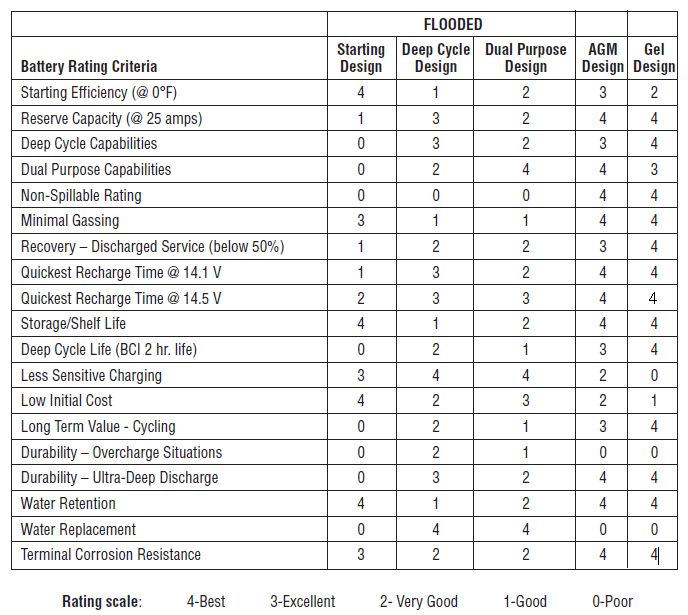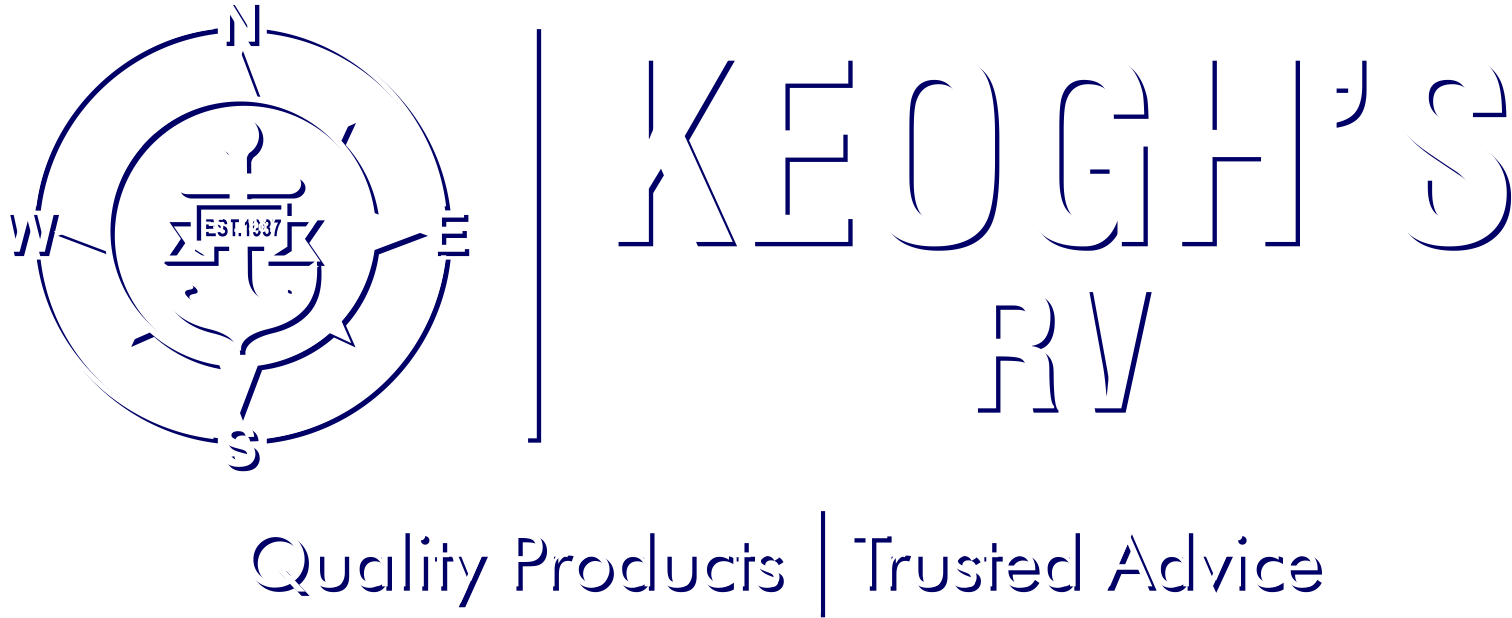Marine, Caravan and RV Batteries
Which battery do I use, and why? Is there a difference between one brand of battery and another? How do I look after my batteries? We explain the difference and provide recommendations about which battery to use and how to look after them.
When you rely on batteries, as we do in our marine, caravan and RV lifestyles; it pays to have a better understanding of batteries, their construction, types, uses and how to look after them.
The fact that batteries usually only last about 2-3 years for most of us in these types of heavy applications is testament to how heavily we use, and how poorly we usually treat batteries. Batteries will actually last from 4 to 10 years when the correct selection is made for the use, then backed up by good charging practices and proper battery maintenance.
Firstly lets look at the criteria for rating batteries so that you might have a better understanding of how to compare batteries.
Battery Rating Criteria
Starting Efficiency - rates the ability of a battery to provide high amperage to “crank the engine” up to the starting RPM. This power comes off the surface of the plates; therefore, many thin plates will deliver the highest starting power.
Reserve Capacity @ 25 Amps @ 80°F - represents the time the battery will continue top operate essential accessories if the alternator or generator would fail. High reserve capacity ratings allow the use of more accessory power demands. This slower, lower discharge comes from the thicknesss of the plates. Thicker plates will deliver a higher reserve capacity.
Deep Cycle Capabilities - represents the ability of the battery to deliver small amounts of current over longer periods of time allowing the battery to withstand long, deep discharges, and long, slow recharges. Again, thicker plates perform better than thinner plates.
Dual Purpose Capabilities - represents the ability of a battery to provide ample starting power and moderate deep cycle service. This design is a compromise between a starting design and a true deep cycle design.
Non-Spillable Rating - is the degree of which the battery design ensures the prevention of leaks and spills allowing for added safety and numerous installation options.
Minimal Gassing-is attributed to the battery's ability to control internal gas pressure, preventing capacity loss from extra gas seepage and allowing care-free use around sensitive electronic equipment. This assumes proper charging, because over-charging will drive hydrogen and oxygen from any battery design.
Recovery from Discharge Service (below 50%) - demonstrates the ability of the battery to be continually recharged from a discharged state below 50% of its full capacity without significant loss of capacity or life cycles.
Quickest Recharge Time @ 14.1 V or 14.5 V - shows the efficiency of a battery's re-charge ability allowing for shorter charging times. Gel batteries are required to charge at a maximum of 14.1 V (14.6 V GelTech Battries) but only need to have 105% of the amp hours returned because they recharge so efficiently. In contrast, AGM battery's are required to be charged at a maximum of 14.5 V, but will need 110% of the amp hours returned. A flooded battery can usually be charged at yet a higher voltage, depending upon the lead alloy; however, they will require 120-130% of the amp hours returned by the charging system.
Storage/Shelf Life-represents the rate at which a fully charged battery that is not being used can retain its charge. If the battery has a long storage life it will have a low self discharge rate and will be able to be inactive for a longer period of time (typical of off-season storage) without losing its capacity ratings or experiencing a significant decrease in its level of charge.
Deep Cycle Life (BCI 2 hr life) - shows the battery's ability to be discharged to a low state of charge and then recharged for numerous cycles in controlled lab test conditions.
Less Sensitive Charging - shows the degree at which battery charging requires strict voltage control in order not to shorten or damage the battery's life. For example GEL cell batteries must be limited to 14.1 V (14.6 V GelTech Battries) while AGM batteries can withstand up to 14.5 recharge voltage.
Low Initial Cost - compares the initial purchase price.
Long Term Value Cycling - determines the long term value of the battery by comparing the initial price in relation to the life cycles the battery design will deliver.
Durability - Overcharge Situation - evaluates the battery's resistance to damage or capacity loss when it's overcharged many times.
Durability - Ultra Deep Discharge - evaluates the battery's resistance to damage or capacity loss by continually discharging close to its zero capacity rating.
Water Retention - shows the ability of the battery design and alloy composition to decrease the amount of water lost during the battery's life. Some battery's are designed to lose very little water during their life eliminating the need to add water.
Water Replacement - indicates if the vent caps or filter plugs can be removed to replace water that may be lost due to excessive gassing from over-charging situations.
Terminal Corrosion Resistance - is the battery's design attributes that prevent acid residue that might cause unwanted corrosion on the terminals and attached wiring and/or nearby equipment. Terminal corrosion can also be relative to the battery's non-spillable rating.
Flooded, AGM or GEL... which is best?
Below is a chart that rates flooded, AGM and GEL battery designs against numerous battery criteria that pertain to application use. See the explanations above for terms to explain their relevance and importance in evaluating the different types of marine, caravan and RV batteries.

Construction
All batteries are not created equal. Automotive batteries generally do not suit marine use. We say generally, because some truck batteries are built tougher than the average automotive battery and may suit displacement vessels with large engine cranking requirements (starting amperage).
As you may appreciate, batteries in marine, caravan and RV situations are subject to more vibration, greater shock loads and high angles of inclination. Cycling batteries (deep cycle or house batteries) are also subject to much a deeper depth of discharge (DOD) than your average battery. Due to this heavy discharge, they are then subject to heavy (and sometimes rapid) charging on a regular basis (sometimes daily) in order to replace the large amount of amps we have used up.
Your average battery just cant take this kind of treatment. Why?
- Most automotive and/or poor quality batteries are not constructed strongly enough to withstand the loads applied to them in the marine, caravan and RV environment. If you think how comfortable it is for a car battery for a minute. They have a nice level place to sit, they just start the car (minimal discharge) and are then re-charged immediately, never being heavily discharged. They also reside in a constant temperature and have a low, steady maintenance charge rate from the vehicle's alternator.
- Excessive gassing when over-charged causes loss of electrolyte. This is a known problem in Valve Regulated Lead Acid (VRLA) batteries (also know as maintenance free batteries) as there is no way to top them up. High charging rates applied to a poor quality, maintenance free (or VRLA) battery will lead to low electrolyte, reducing the batteries life and eventually rendering the battery useless.
- The sometimes violent motion with angles of incline up to 30° will cause the plates inside the battery to move, buckle, bend and eventually render the battery useless.
- It is also worthy to note that USA made batteries conform to a standard, and so what they state on their spec sheet is usually true. Batteries made in other countries are not subject to such stringent regulation, and so you don't always get what you pay for.
We have seen many Chinese batteries used in heavy discharge situations, such as electric trolling motors, anchor windlasses' and bow thrusters in boats, or for house power use in marine, caravan or RV's. Under these loads, and due to heavy discharge / re-charge, the battery gasses heavily, discharging its electrolyte, thus causing complete battery failure well within 12 months.
Batteries aren't cheap at best, being let down by cheap batteries and installing them twice just doesn't make economical sense, let alone the inconvenience and hassle.
Battery Type
There are 4 main battery types. Listed below are the type, application, advantage and disadvantage of each type.
|
Type |
Applications |
Advantages |
Disadvantages |
|
|
|
|
|
(AGM) |
|
|
|
|
(FLA) |
|
|
|
|
(Li-ion) |
|
|
|
Sealed, Valve-Regulated (SVR) Gelled-electrolyte batteries offer many significant advantages over conventional “flooded” batteries. Gel batteries are spillproof* and leakproof, and resist over-discharges that can shorten the life of the battery.
Gel batteries have a self-discharge rate of less than 1% per month (at 68°F). They provide ample cranking amperage for quick, sure starts, and deliver longer trolling time than comparable flooded models. Their SVR design minimizes gassing, making them safe to install around people and sensitive electronic equipment. Gel batteries offer a viable alternative when you can only choose one battery.
Gel batteries are maintenance-free.
Charging: For longest life, always use a good, constant potential, voltage-regulated charger. For 12-volt Gel batteries, charge to at least 13.8 volts, but no more than 14.1 volts (14.6 V GelTech Battries) at 68°F (20°C). Do not charge in a sealed container.
Sealed, Valve-Regulated (SVR) Absorbed Glass Mat (AGM) batteries use special absorbed electrolyte technology that is superior to flooded lead-acid batteries. Fine, highly porous microfiber glass separators absorb the electrolyte*, increasing efficiency by lowering internal resistance and boosting capacity.
Lower internal resistance also means that the batteries can be recharged faster than conventional batteries, allowing the user to put them back into operation sooner.
The completely sealed, valve-regulated AGM battery eliminates gas emissions and acid leakage for longer and safer battery operation. AGM batteries are also completely maintenance-free.
Charging: Use a good, constant potential, voltage-regulated charger. For 12-volt AGM batteries, charge to at least 14.4 volts, but no more than 14.6 volts at 68°F (20°C). Do not charge in a sealed container.
Flooded lead-acid batteries are the most widely used batteries both in automotive and marine applications. Lead-acid batteries are usually less expensive than either the Gel or AGM batteries, but do not provide the same cycle life and convenience.
Most flooded batteries require maintenance. Electrolyte levels must be maintained above the cell’s plates.
We only sell a complete Lithium battery system i.e. matched lithium battery and a battery management system. Enerdrive has a range of lithium battery kits to suit nearly every application, available in 100Ah, 200Ah, 300Ah, 400Ah & 500Ah capacities.
Lithium Ion batteries have a high energy density and are perfect for cyclic applications. They offer savings of up to 70% in volume and weight compared to traditional lead-acid batteries. Lithium batteries offer ult

